Abstract
Ampicillin-sulbactam, ticarcillin-clavulanate, cefoxitin, cefotetan, and ceftizoxime are promoted for the treatment of mixed aerobic-anaerobic bacterial infections. Their activities have been compared in vitro but not in vivo. In order to assess the in vivo activities of these agents in serum and interstitial fluid, we administered single, intravenous doses of these antimicrobial agents to healthy subjects. Concentrations of the antimicrobial agents in serum and suction-induced blister fluid and bactericidal activity were measured by high-pressure liquid chromatography and the standard methodology of the National Committee for Clinical Laboratory Standards, respectively. The organisms used for bactericidal activity tests were one isolate each of Staphylococcus aureus, Klebsiella pneumoniae, and Bacteroides fragilis. Pharmacokinetic parameters in serum and blister fluid were similar to those derived in other investigations. Of note were the high and prolonged concentrations of ticarcillin and cefotetan in blister fluid, despite high-level serum protein binding. The bactericidal activities in serum and blister fluid reflected the relative in vitro activities and kinetic dispositions of the various antimicrobial agents except for the bactericidal activity of cefotetan, which was substantially lower in blister fluid than serum, despite a blister fluid:serum area under the concentration-time curve ratio of 1.5. Similarly, the activity of ticarcillin-clavulanate in blister fluid was also substantially less than would have been predicted by the blister fluid:serum ratio of the area under the concentration-time curve of 1.1, possibly because of the low concentrations of clavulanate in blister fluid. The rankings of the in vivo bactericidal activities of the five drugs were as follows: for S. aureus, ampicillin-sulbactam > ticarcillin-clavulanate > ceftizoxime > cefoxitin > cefotetan; for K. pneumoniae, ceftizoxime > cefotetan > ampicillin-sulbactam = ticarcillin-clavulanate > cefoxitin; and for B.fragilis, ticarcillin-clavulanate > cefotetan > ceftizoxime > ampicillin-sulbactam = cefoxitin.
Full text
PDF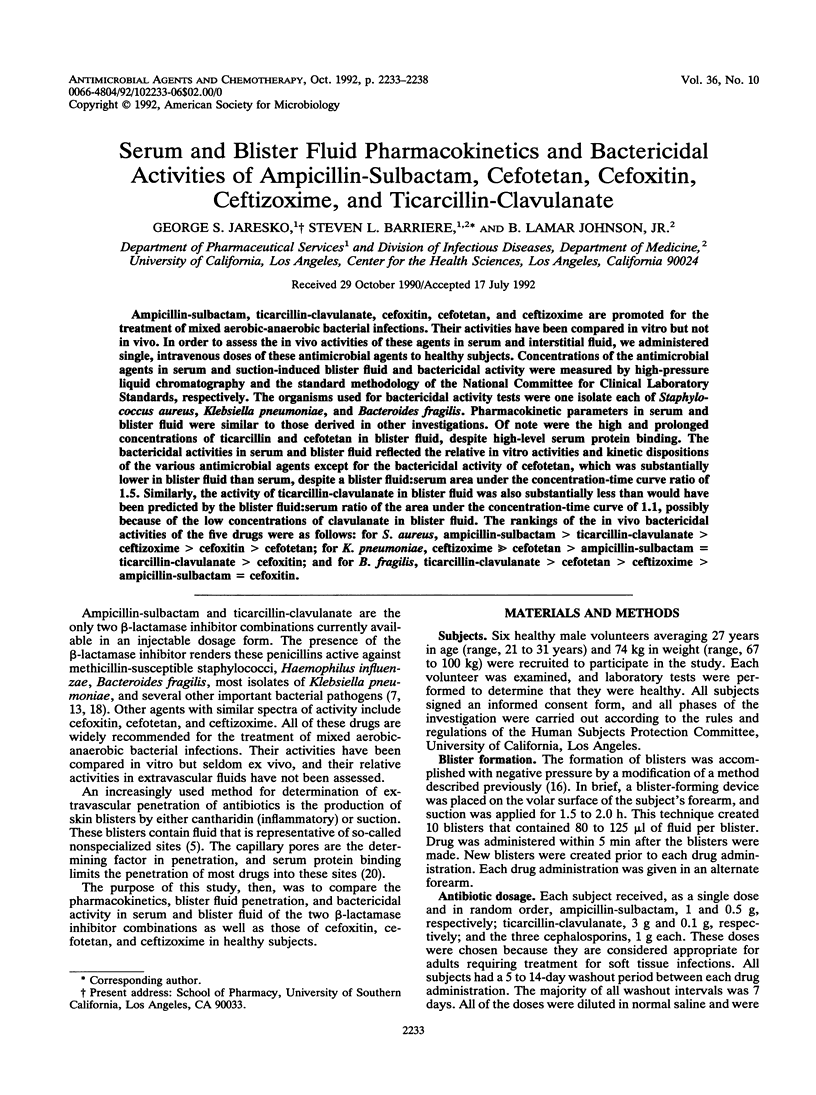
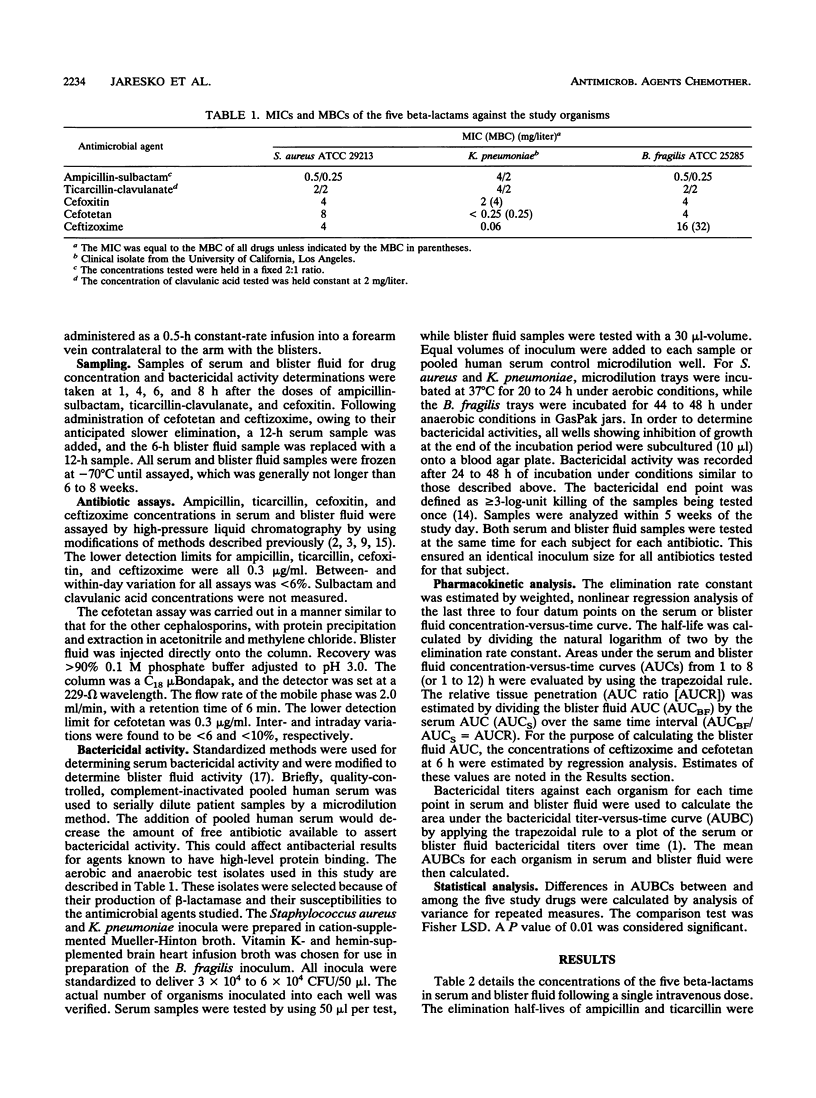
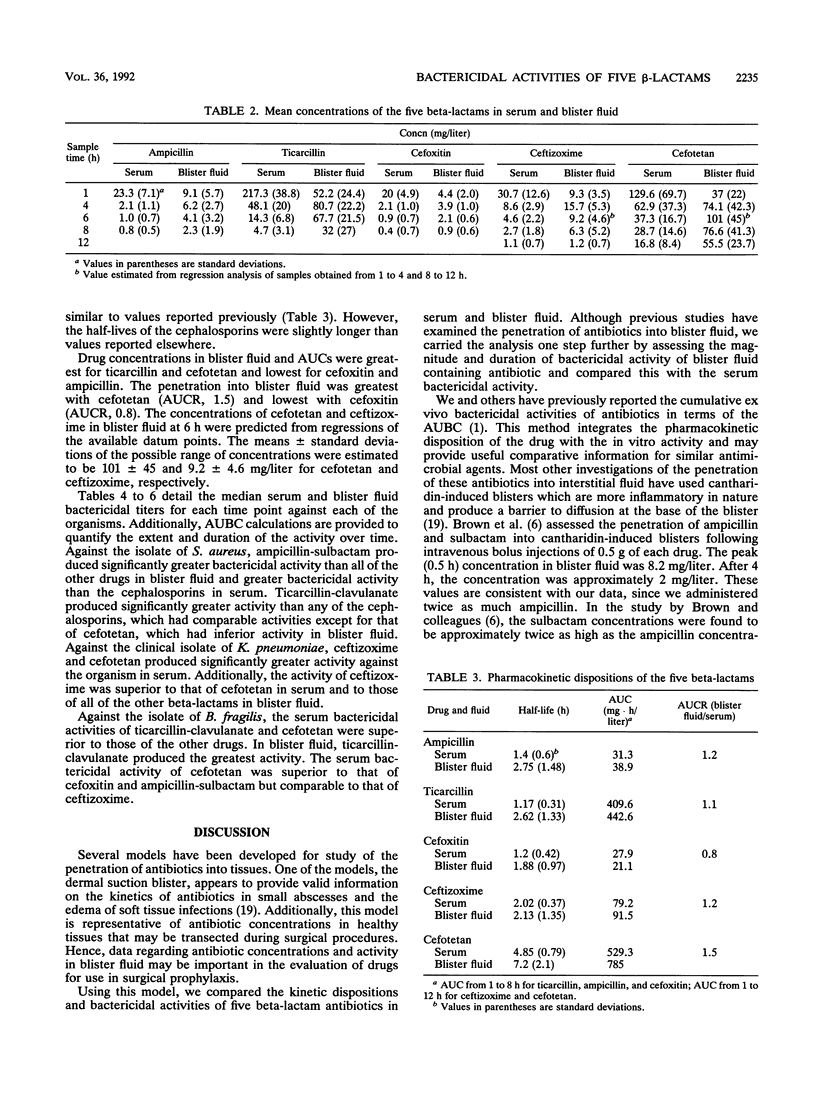
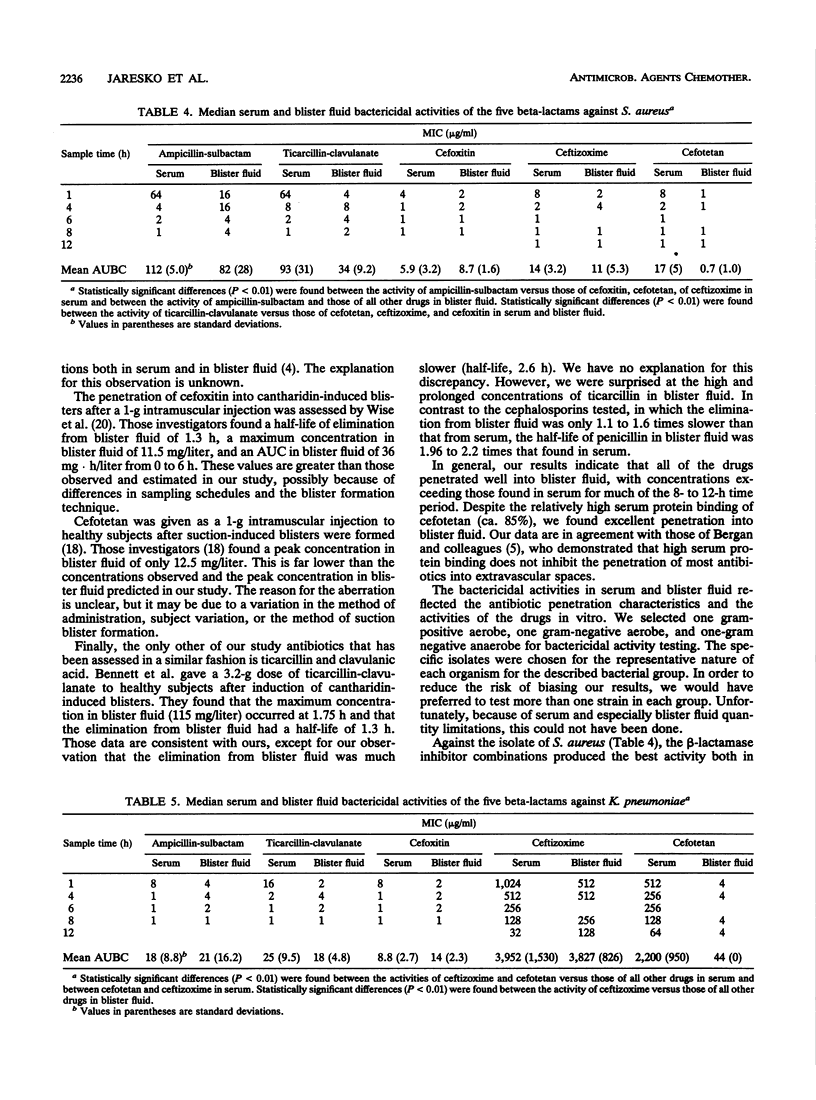
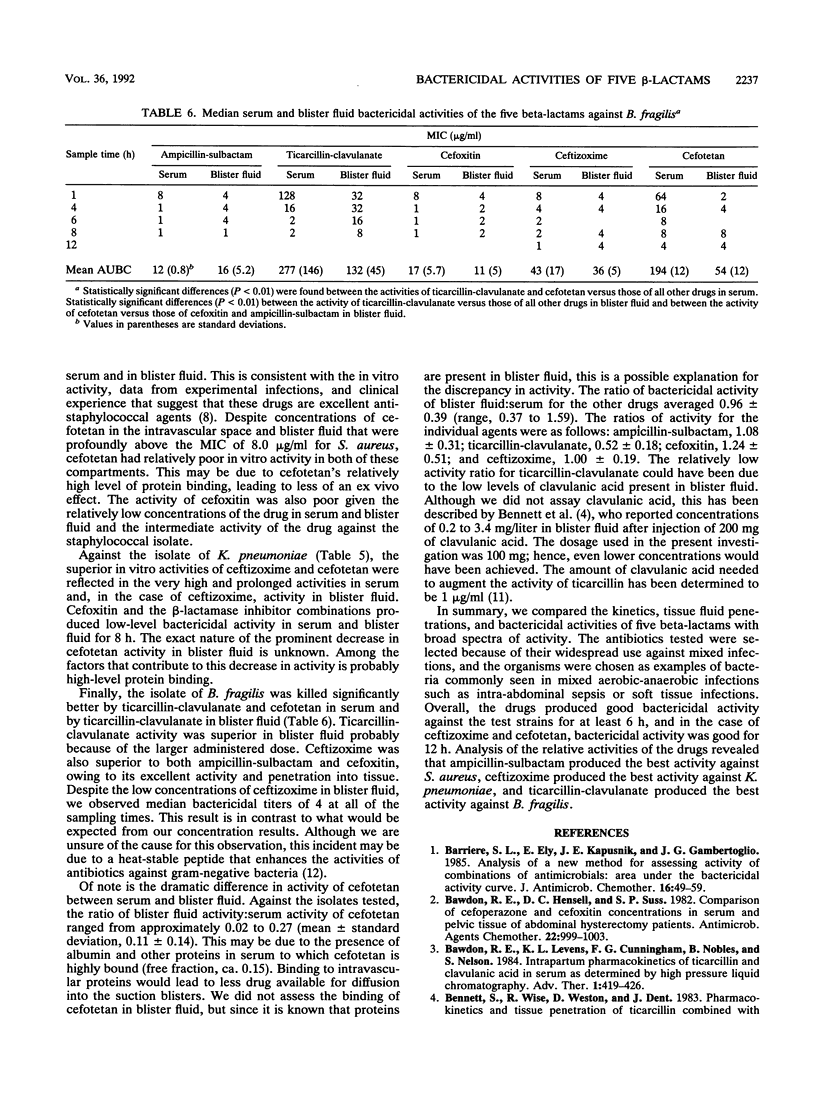
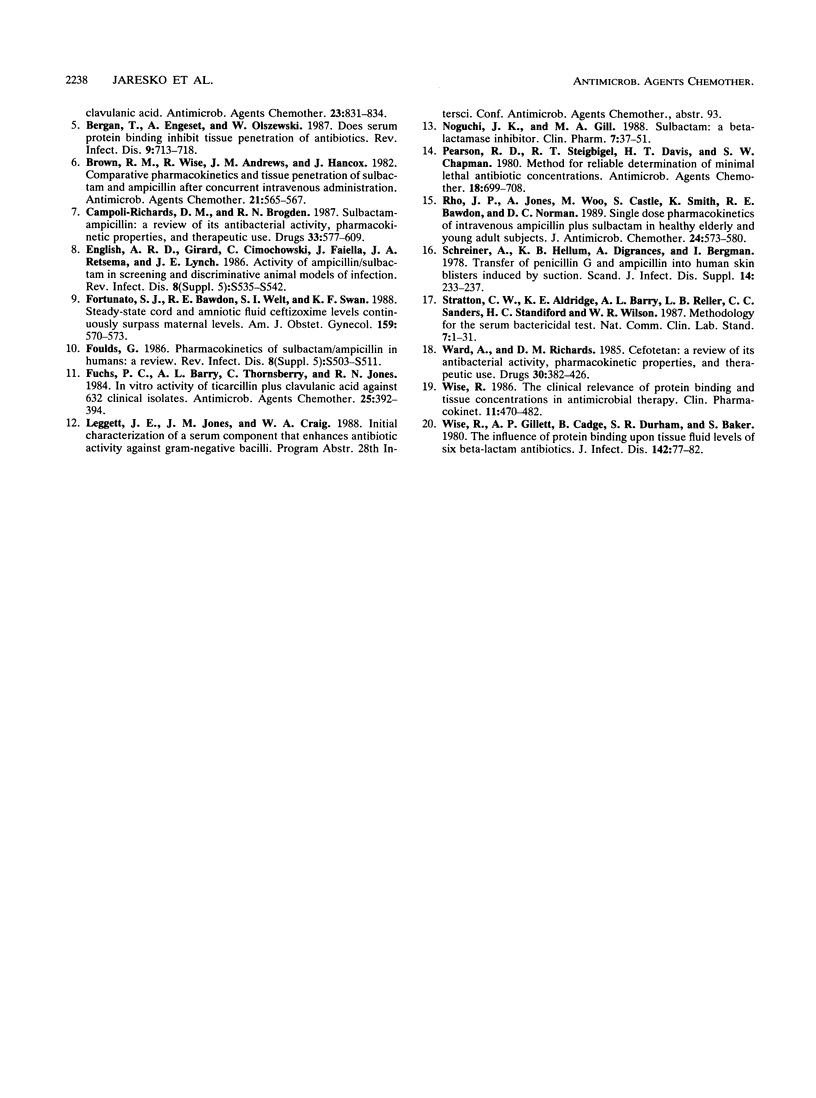
Selected References
These references are in PubMed. This may not be the complete list of references from this article.
- Barriere S. L., Ely E., Kapusnik J. E., Gambertoglio J. G. Analysis of a new method for assessing activity of combinations of antimicrobials: area under the bactericidal activity curve. J Antimicrob Chemother. 1985 Jul;16(1):49–59. doi: 10.1093/jac/16.1.49. [DOI] [PubMed] [Google Scholar]
- Bawdon R. E., Hemsell D. L., Guss S. P. Comparison of cefoperazone and cefoxitin concentrations in serum and pelvic tissue of abdominal hysterectomy patients. Antimicrob Agents Chemother. 1982 Dec;22(6):999–1003. doi: 10.1128/aac.22.6.999. [DOI] [PMC free article] [PubMed] [Google Scholar]
- Bergan T., Engeset A., Olszewski W. Does serum protein binding inhibit tissue penetration of antibiotics? Rev Infect Dis. 1987 Jul-Aug;9(4):713–718. doi: 10.1093/clinids/9.4.713. [DOI] [PubMed] [Google Scholar]
- Brown R. M., Wise R., Andrews J. M., Hancox J. Comparative pharmacokinetics and tissue penetration of sulbactam and ampicillin after concurrent intravenous administration. Antimicrob Agents Chemother. 1982 Apr;21(4):565–567. doi: 10.1128/aac.21.4.565. [DOI] [PMC free article] [PubMed] [Google Scholar]
- Campoli-Richards D. M., Brogden R. N. Sulbactam/ampicillin. A review of its antibacterial activity, pharmacokinetic properties, and therapeutic use. Drugs. 1987 Jun;33(6):577–609. doi: 10.2165/00003495-198733060-00003. [DOI] [PubMed] [Google Scholar]
- English A. R., Girard D., Cimochowski C., Faiella J., Retsema J. A., Lynch J. E. Activity of sulbactam/ampicillin in screening and discriminative animal models of infection. Rev Infect Dis. 1986 Nov-Dec;8 (Suppl 5):S535–S542. doi: 10.1093/clinids/8.supplement_5.s535. [DOI] [PubMed] [Google Scholar]
- Fortunato S. J., Bawdon R. E., Welt S. I., Swan K. F. Steady-state cord and amniotic fluid ceftizoxime levels continuously surpass maternal levels. Am J Obstet Gynecol. 1988 Sep;159(3):570–573. doi: 10.1016/s0002-9378(88)80010-3. [DOI] [PubMed] [Google Scholar]
- Foulds G. Pharmacokinetics of sulbactam/ampicillin in humans: a review. Rev Infect Dis. 1986 Nov-Dec;8 (Suppl 5):S503–S511. doi: 10.1093/clinids/8.supplement_5.503. [DOI] [PubMed] [Google Scholar]
- Fuchs P. C., Barry A. L., Thornsberry C., Jones R. N. In vitro activity of ticarcillin plus clavulanic acid against 632 clinical isolates. Antimicrob Agents Chemother. 1984 Mar;25(3):392–394. doi: 10.1128/aac.25.3.392. [DOI] [PMC free article] [PubMed] [Google Scholar]
- Noguchi J. K., Gill M. A. Sulbactam: a beta-lactamase inhibitor. Clin Pharm. 1988 Jan;7(1):37–51. [PubMed] [Google Scholar]
- Pearson R. D., Steigbigel R. T., Davis H. T., Chapman S. W. Method of reliable determination of minimal lethal antibiotic concentrations. Antimicrob Agents Chemother. 1980 Nov;18(5):699–708. doi: 10.1128/aac.18.5.699. [DOI] [PMC free article] [PubMed] [Google Scholar]
- Rho J. P., Jones A., Woo M., Castle S., Smith K., Bawdon R. E., Norman D. C. Single-dose pharmacokinetics of intravenous ampicillin plus sulbactam in healthy elderly and young adult subjects. J Antimicrob Chemother. 1989 Oct;24(4):573–580. doi: 10.1093/jac/24.4.573. [DOI] [PubMed] [Google Scholar]
- Schreiner A., Hellum K. B., Digranes A., Bergman I. Transfer of penicillin G and ampicillin into human skin blisters induced by suction. Scand J Infect Dis Suppl. 1978;(14):233–237. [PubMed] [Google Scholar]
- Ward A., Richards D. M. Cefotetan. A review of its antibacterial activity, pharmacokinetic properties and therapeutic use. Drugs. 1985 Nov;30(5):382–426. doi: 10.2165/00003495-198530050-00002. [DOI] [PubMed] [Google Scholar]
- Wise R., Gillett A. P., Cadge B., Durham S. R., Baker S. The influence of protein binding upon tissue fluid levels of six beta-lactam antibiotics. J Infect Dis. 1980 Jul;142(1):77–82. doi: 10.1093/infdis/142.1.77. [DOI] [PubMed] [Google Scholar]
- Wise R. The clinical relevance of protein binding and tissue concentrations in antimicrobial therapy. Clin Pharmacokinet. 1986 Nov-Dec;11(6):470–482. doi: 10.2165/00003088-198611060-00004. [DOI] [PubMed] [Google Scholar]


